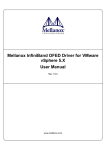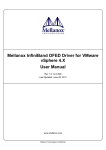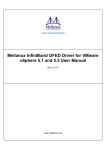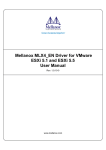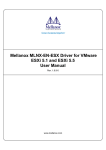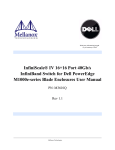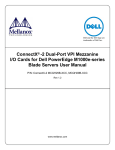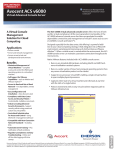Download Mellanox OFED Linux User's Manual
Transcript
Mellanox InfiniBand OFED Driver for VMware
vSphere 5.X
User Manual
Rev 1.8.0
www.mellanox.com
NOTE:
THIS HARDWARE, SOFTWARE OR TEST SUITE PRODUCT (“PRODUCT(S)”) AND ITS RELATED DOCUMENTATION ARE
PROVIDED BY MELLANOX TECHNOLOGIES “AS-IS” WITH ALL FAULTS OF ANY KIND AND SOLELY FOR THE PURPOSE
OF AIDING THE CUSTOMER IN TESTING APPLICATIONS THAT USE THE PRODUCTS IN DESIGNATED SOLUTIONS. THE
CUSTOMER'S MANUFACTURING TEST ENVIRONMENT HAS NOT MET THE STANDARDS SET BY MELLANOX
TECHNOLOGIES TO FULLY QUALIFY THE PRODUCTO(S) AND/OR THE SYSTEM USING IT. THEREFORE, MELLANOX
TECHNOLOGIES CANNOT AND DOES NOT GUARANTEE OR WARRANT THAT THE PRODUCTS WILL OPERATE WITH THE
HIGHEST QUALITY. ANY EXPRESS OR IMPLIED WARRANTIES, INCLUDING, BUT NOT LIMITED TO, THE IMPLIED
WARRANTIES OF MERCHANTABILITY, FITNESS FOR A PARTICULAR PURPOSE AND NONINFRINGEMENT ARE
DISCLAIMED. IN NO EVENT SHALL MELLANOX BE LIABLE TO CUSTOMER OR ANY THIRD PARTIES FOR ANY DIRECT,
INDIRECT, SPECIAL, EXEMPLARY, OR CONSEQUENTIAL DAMAGES OF ANY KIND (INCLUDING, BUT NOT LIMITED TO,
PAYMENT FOR PROCUREMENT OF SUBSTITUTE GOODS OR SERVICES; LOSS OF USE, DATA, OR PROFITS; OR BUSINESS
INTERRUPTION) HOWEVER CAUSED AND ON ANY THEORY OF LIABILITY, WHETHER IN CONTRACT, STRICT LIABILITY,
OR TORT (INCLUDING NEGLIGENCE OR OTHERWISE) ARISING IN ANY WAY FROM THE USE OF THE PRODUCT(S) AND
RELATED DOCUMENTATION EVEN IF ADVISED OF THE POSSIBILITY OF SUCH DAMAGE.
Mellanox Technologies
350 Oakmead Parkway
Sunnyvale, CA 94085
U.S.A.
www.mellanox.com
Tel: (408) 970-3400
Fax: (408) 970-3403
Mellanox Technologies, Ltd.
PO Box 586 Hermon Building
Yokneam 20692
Israel
Tel: +972-4-909-7200
Fax: +972-4-959-3245
© Copyright 2011. Mellanox Technologies, Inc. All Rights Reserved.
Mellanox®, BridgeX®, ConnectX®, CORE-Direct®, InfiniBlast®, InfiniBridge®, InfiniHost®, InfiniRISC®, InfiniScale®, InfiniPCI®,
PhyX®, Virtual Protocol Interconnect and Voltaire are registered trademarks of Mellanox Technologies, Ltd.
FabricIT and SwitchX are trademarks of Mellanox Technologies, Ltd.
All other trademarks are property of their respective owners.
2
Mellanox Technologies
Document Number: 3464
Rev 1.8.0
Table of Contents
Table of Contents . . . . . . . . . . . . . . . . . . . . . . . . . . . . . . . . . . . . . . . . . . . . . . . . . . . . . . . . . . . . . . . . . 3
List of Tables . . . . . . . . . . . . . . . . . . . . . . . . . . . . . . . . . . . . . . . . . . . . . . . . . . . . . . . . . . . . . . . . . . . . . 4
Revision History . . . . . . . . . . . . . . . . . . . . . . . . . . . . . . . . . . . . . . . . . . . . . . . . . . . . . . . . . . . . . . . . . . 5
About this Manual . . . . . . . . . . . . . . . . . . . . . . . . . . . . . . . . . . . . . . . . . . . . . . . . . . . . . . . . . . . . . . . . 6
Intended Audience . . . . . . . . . . . . . . . . . . . . . . . . . . . . . . . . . . . . . . . . . . . . . . . . . . . . . . . . . . . . . . . . . 6
Typographical Conventions . . . . . . . . . . . . . . . . . . . . . . . . . . . . . . . . . . . . . . . . . . . . . . . . . . . . . . . . . . 6
Common Abbreviations and Acronyms . . . . . . . . . . . . . . . . . . . . . . . . . . . . . . . . . . . . . . . . . . 7
Glossary . . . . . . . . . . . . . . . . . . . . . . . . . . . . . . . . . . . . . . . . . . . . . . . . . . . . . . . . . . . . . . . . . . . . . . . . . 9
Related Documentation . . . . . . . . . . . . . . . . . . . . . . . . . . . . . . . . . . . . . . . . . . . . . . . . . . . . . . . . . . . . . 10
Support and Updates Webpage . . . . . . . . . . . . . . . . . . . . . . . . . . . . . . . . . . . . . . . . . . . . . . . . . . . . . . . 10
Chapter 1
Mellanox InfiniBand OFED Driver for VMware® vSphere Overview . . . . . . . . . 11
1.1
1.2
1.3
1.4
1.5
Introduction to Mellanox InfiniBand OFED for VMware - - - - - - - - - - - - - - - - - - - - - - - - - - - - Introduction to Mellanox InfiniBand Adapters - - - - - - - - - - - - - - - - - - - - - - - - - - - - - - - - - - - Mellanox OFED Package - - - - - - - - - - - - - - - - - - - - - - - - - - - - - - - - - - - - - - - - - - - - - - - - - 1.3.1 Software Components . . . . . . . . . . . . . . . . . . . . . . . . . . . . . . . . . . . . . . . . . . . . . . . . . . . . . . .
mlx4 InfiniBand Driver - - - - - - - - - - - - - - - - - - - - - - - - - - - - - - - - - - - - - - - - - - - - - - - - - - - 1.4.1 ULPs. . . . . . . . . . . . . . . . . . . . . . . . . . . . . . . . . . . . . . . . . . . . . . . . . . . . . . . . . . . . . . . . . . . . .
Supported Hardware Compatibility - - - - - - - - - - - - - - - - - - - - - - - - - - - - - - - - - - - - - - - - - - - -
11
11
11
11
12
12
12
Chapter 2
Installing Mellanox InfiniBand OFED Driver for VMware vSphere . . . . . . . . . . . 13
Chapter 3
Uninstalling Mellanox InfiniBand OFED Driver . . . . . . . . . . . . . . . . . . . . . . . . . . . 14
Chapter 4
Driver Features . . . . . . . . . . . . . . . . . . . . . . . . . . . . . . . . . . . . . . . . . . . . . . . . . . . . . . 15
4.1
Chapter 5
IP over InfiniBand - - - - - - - - - - - - - - - - - - - - - - - - - - - - - - - - - - - - - - - - - - - - - - - - - - - - - - - 15
4.1.1 IPoIB Overview . . . . . . . . . . . . . . . . . . . . . . . . . . . . . . . . . . . . . . . . . . . . . . . . . . . . . . . . . . . . 15
4.1.2 IPoIB Configuration. . . . . . . . . . . . . . . . . . . . . . . . . . . . . . . . . . . . . . . . . . . . . . . . . . . . . . . . . 15
Configuring the Mellanox InfiniBand OFED Driver for VMware vSphere . . . . . 16
5.1
5.2
Configuring an Uplink - - - - - - - - - - - - - - - - - - - - - - - - - - - - - - - - - - - - - - - - - - - - - - - - - - - Configuring VMware ESXi Server Settings - - - - - - - - - - - - - - - - - - - - - - - - - - - - - - - - - - - - - 5.2.1 Subnet Manager . . . . . . . . . . . . . . . . . . . . . . . . . . . . . . . . . . . . . . . . . . . . . . . . . . . . . . . . . . . .
5.2.2 Networking. . . . . . . . . . . . . . . . . . . . . . . . . . . . . . . . . . . . . . . . . . . . . . . . . . . . . . . . . . . . . . . .
5.2.3 Virtual Local Area Network (VLAN) Support . . . . . . . . . . . . . . . . . . . . . . . . . . . . . . . . . . . .
5.2.4 Maximum Transmit Unit (MTU) Configuration . . . . . . . . . . . . . . . . . . . . . . . . . . . . . . . . . . .
5.2.5 High Availability . . . . . . . . . . . . . . . . . . . . . . . . . . . . . . . . . . . . . . . . . . . . . . . . . . . . . . . . . . .
16
16
16
17
17
18
19
Mellanox Techologies
3
List of Tables
Table 1:
Revision History . . . . . . . . . . . . . . . . . . . . . . . . . . . . . . . . . . . . . . . . . . . . . . . . . . . . . . . . . 5
Table 2:
Typographical Conventions . . . . . . . . . . . . . . . . . . . . . . . . . . . . . . . . . . . . . . . . . . . . . . . . 6
Table 3:
Abbreviations and Acronyms . . . . . . . . . . . . . . . . . . . . . . . . . . . . . . . . . . . . . . . . . . . . . . . 7
Table 4:
Glossary . . . . . . . . . . . . . . . . . . . . . . . . . . . . . . . . . . . . . . . . . . . . . . . . . . . . . . . . . . . . . . . 9
Table 5:
Reference Documents . . . . . . . . . . . . . . . . . . . . . . . . . . . . . . . . . . . . . . . . . . . . . . . . . . . . 10
4
Mellanox Techologies
Rev 1.8.0
Revision History
Table 1 - Revision History
Revision
Date
1.6.8
June 2012
1.4.1-2.0.000
May 2011
Change Description
Initial release
Mellanox Techologies
5
Rev 1.8.0
About this Manual
This document provides instructions for installing and using drivers for Mellanox Technologies
ConnectX®-2 and ConnectX®-3 based network adapter cards in a VMware ESXi Server environment.
Intended Audience
This manual is intended for system administrators responsible for the installation, configuration,
management and maintenance of the software and hardware of InfiniBand adapter cards. It is also
intended for application developers.
Typographical Conventions
Table 2 - Typographical Conventions
Description
6
Convention
File names
file.extension
Directory names
directory
Commands and their parameters
command param1
Optional items
[ ]
Mutually exclusive parameters
{ p1 | p2 | p3
}
Optional mutually exclusive parameters
[ p1 | p2 | p3
]
Prompt of a user command under
bash shell
hostname$
Prompt of a root command under bash
shell
hostname#
Prompt of a user command under tcsh
shell
tcsh$
Environment variables
VARIABLE
Code example
if (a==b){};
Comment at the beginning of a code
line
!, #
Characters to be typed by users as-is
bold font
Keywords
bold font
Mellanox Techologies
Example
Rev 1.8.0
Table 2 - Typographical Conventions
Description
Convention
Variables for which users supply specific values
Italic font
Emphasized words
Italic font
Pop-up menu sequences
menu1 --> menu2 ->... --> item
Note
Note:
Warning
Warning!
Example
These are emphasized words
Common Abbreviations and Acronyms
Table 3 - Abbreviations and Acronyms (Sheet 1 of 2)
Abbreviation / Acronym
Whole Word / Description
B
(Capital) ‘B’ is used to indicate size in bytes or multiples of
bytes (e.g., 1KB = 1024 bytes, and 1MB = 1048576 bytes)
b
(Small) ‘b’ is used to indicate size in bits or multiples of bits
(e.g., 1Kb = 1024 bits)
FW
Firmware
HCA
Host Channel Adapter
HW
Hardware
IB
InfiniBand
LSB
Least significant byte
lsb
Least significant bit
MSB
Most significant byte
msb
Most significant bit
NIC
Network Interface Card
SW
Software
IPoIB
IP over InfiniBand
PFC
Priority Flow Control
PR
Path Record
SL
Service Level
SRP
SCSI RDMA Protocol
Mellanox Techologies
7
Rev 1.8.0
Table 3 - Abbreviations and Acronyms (Sheet 2 of 2)
Abbreviation / Acronym
8
Whole Word / Description
ULP
Upper Level Protocol
VL
Virtual Lanes
Mellanox Techologies
Rev 1.8.0
Glossary
The following is a list of concepts and terms related to InfiniBand in general and to Subnet Managers in particular. It is included here for ease of reference, but the main reference remains the InfiniBand Architecture Specification.
Table 4 - Glossary (Sheet 1 of 2)
Channel Adapter
(CA), Host Channel
Adapter (HCA)
An IB device that terminates an IB link and executes transport
functions. This may be an HCA (Host CA) or a TCA (Target
CA).
HCA Card
A network adapter card based on an InfiniBand channel
adapter device.
IB Devices
Integrated circuit implementing InfiniBand compliant communication.
IB Cluster/Fabric/
Subnet
A set of IB devices connected by IB cables.
In-Band
A term assigned to administration activities traversing the IB
connectivity only.
LID
An address assigned to a port (data sink or source point) by the
Subnet Manager, unique within the subnet, used for directing
packets within the subnet.
Local Device/Node/
System
The IB Host Channel Adapter (HCA) Card installed on the
machine running IBDIAG tools.
Local Port
The IB port of the HCA through which IBDIAG tools connect
to the IB fabric.
Master Subnet Manager
The Subnet Manager that is authoritative, that has the reference configuration information for the subnet. See Subnet
Manager.
Multicast Forwarding Tables
A table that exists in every switch providing the list of ports to
forward received multicast packet. The table is organized by
MLID.
Network Interface
Card (NIC)
A network adapter card that plugs into the PCI Express slot
and provides one or more ports to an Ethernet network.
Standby Subnet Manager
A Subnet Manager that is currently quiescent, and not in the
role of a Master Subnet Manager, by agency of the master SM.
See Subnet Manager.
Subnet Administrator (SA)
An application (normally part of the Subnet Manager) that
implements the interface for querying and manipulating subnet
management data.
Mellanox Techologies
9
Rev 1.8.0
Table 4 - Glossary (Sheet 2 of 2)
Subnet Manager (SM)
One of several entities involved in the configuration and control of the subnet.
Unicast Linear Forwarding Tables (LFT)
A table that exists in every switch providing the port through
which packets should be sent to each LID.
Related Documentation
Table 5 - Reference Documents
Document Name
Description
MFT User’s Manual
Mellanox Firmware Tools User’s Manual. See
under docs/ folder of installed package.
MFT Release Notes
Release Notes for the Mellanox Firmware Tools.
See under docs/ folder of installed package.
Support and Updates Webpage
Please visit http://www.mellanox.com > Products > Adapter IB/VPI SW/VMware Drivers for downloads, FAQ, troubleshooting, future updates to this manual, etc.
10
Mellanox Techologies
Rev 1.8.0
1
Mellanox InfiniBand OFED Driver for VMware®
vSphere Overview
1.1
Introduction to Mellanox InfiniBand OFED for VMware
Mellanox OFED is a single Virtual Protocol Internconnect (VPI) software stack based on the
OpenFabrics (OFED) Linux stack adapted for VMware, and operates across all Mellanox network
adapter solutions supporting 10, 20 and 40Gb/s InfiniBand (IB) and 2.5 or 5.0 GT/s PCI Express
2.0 and 3.0 uplinks to servers.
All Mellanox network adapter cards are compatible with OpenFabrics-based RDMA protocols and
software, and are supported with major operating system distributions.
1.2
Introduction to Mellanox InfiniBand Adapters
Mellanox InfiniBand (IB) adapters, which are based on Mellanox ConnectX®, ConnectX®-2 and
ConnectX®-3 adapter devices, provide leading server and storage I/O performance with flexibility
to support the myriad of communication protocols and network fabrics over a single device, without sacrificing functionality when consolidating I/O. For example, IB-enabled adapters can support:
Connectivity to 10, 20, 40 and 56Gb/s InfiniBand switches
A unified application programming interface with access to communication protocols
including: Networking (TCP, IP, UDP, sockets), Storage (NFS, CIFS, iSCSI, SRP and
Clustered Storage), Clustering (MPI, DAPL, RDS, sockets), and Management (SNMP,
SMI-S)
Communication protocol acceleration engines including: networking, storage, cluster-
ing, virtualization and RDMA with enhanced quality of service
1.3
Mellanox OFED Package
1.3.1 Software Components
MLNX_OFED_VMware contains the following software components:
CPU architectures:
x86_64
ESXi Hypervisor:
ESXi5.0 with BUILD ID: 469512
ESXi5.0 U1 with BUILD ID: 623860
Firmware versions:
ConnectX®-2: 2.9.1000 and above
ConnectX®-3: 2.10.0700 and above
Mellanox Techologies
11
Rev 1.8.0
1.4
Mellanox InfiniBand OFED Driver for VMware® vSphere Overview
mlx4 InfiniBand Driver
MLNX-OFED-ESXi package contains:
MLNX-OFED-ESXi-1.6.8.zip - Hypervisor bundle which contains the following ker-
nel modules:
mlx4_core (ConnectX family low-level PCI driver)
mlx4_ib (ConnectX family InfiniBand driver)
ib_core
ib_sa
ib_mad
ib_umad
ib_ipoib
1.4.1 ULPs
IPoIB
The IP over IB (IPoIB) driver is a network interface implementation over InfiniBand. IPoIB
encapsulates IP datagrams over an InfiniBand connected or datagram transport service. IPoIB preappends the IP datagrams with an encapsulation header, and sends the outcome over the InfiniBand transport service. The interface supports unicast, multicast and broadcast. For details, see
Chapter 4.1, “IP over InfiniBand”.
On VMware ESXi Server, IPoIB supports Unreliable Datagram (UD) mode only, note
that Reliable Connected (RC) mode is not supported.
1.5
Supported Hardware Compatibility
For the supported hardware compatibility list (HCL), please refer to:
http://communities.vmware.com/cshwsw.jspa?vendor=mellanox
12
Mellanox Techologies
Rev 1.8.0
2
Installing Mellanox InfiniBand OFED Driver for VMware
vSphere
This chapter describes how to install and test the Mellanox InfiniBand OFED Driver for VMware
vSphere package on a single host machine with Mellanox InfiniBand hardware installed.
The InfiniBand OFED driver installation on VMware ESXi Server 5.0 is done using VMware's
VIB bundles.
Please uninstall any previous Mellanox driver packages prior to installing the new version.
» To install the driver:
1. Log into the ESXi5.0 server with root permissions.
#> esxcli software vib install -d <bundle_file>
2. Reboot the machine.
3. Verify the driver was installed successfully.
#> esxcli software vib list
net-ib-core
1.6.8
net-ib-ipoib
1.6.8
net-ib-mad
1.6.8
net-ib-sa
1.6.8
net-ib-umad
1.6.8
net-mlx4-core
1.6.8
net-mlx4-ib
1.6.8
| grep Mellanox
OEM.500.0.0.472560
OEM.500.0.0.472560
OEM.500.0.0.472560
OEM.500.0.0.472560
OEM.500.0.0.472560
OEM.500.0.0.472560
OEM.500.0.0.472560
Mellanox
Mellanox
Mellanox
Mellanox
Mellanox
Mellanox
Mellanox
PartnerSupported
PartnerSupported
PartnerSupported
PartnerSupported
PartnerSupported
PartnerSupported
PartnerSupported
2012-05-09
2012-05-09
2012-05-09
2012-05-09
2012-05-09
2012-05-09
2012-05-09
After the installation process, all kernel modules are loaded automatically upon boot.
Mellanox Techologies
13
Uninstalling Mellanox InfiniBand OFED Driver
3
Uninstalling Mellanox InfiniBand OFED Driver
» To uninstall the driver:
1. Log into the ESXi5.0 server with root permissions.
#>
#>
#>
#>
#>
#>
#>
esxcli
esxcli
esxcli
esxcli
esxcli
esxcli
esxcli
software
software
software
software
software
software
software
2. Reboot the server.
14
Mellanox Techologies
vib
vib
vib
vib
vib
vib
vib
remove
remove
remove
remove
remove
remove
remove
-n
-n
-n
-n
-n
-n
-n
net-ib-ipoib
net-mlx4-ib
net-ib-umad
net-ib-sa
net-ib-mad
net-ib-core
net-mlx4-core
Rev 1.8.0
4
Driver Features
4.1
IP over InfiniBand
4.1.1 IPoIB Overview
The IP over IB (IPoIB) driver is a network interface implementation over InfiniBand. IPoIB
encapsulates Datagram transport service. The IPoIB driver, ib_ipoib, exploits the following Connect®X/ConnectX®-2/ConnectX®-3 capabilities:
Uses any CX IB ports (one or two)
Inserts IP/UDP/TCP checksum on outgoing packets
Calculates checksum on received packets
Support net device TSO through CX LSO capability to defragment large datagrams to
MTU quantas.
Unreliable Datagram
IPoIB also supports the following software based enhancements:
Large Receive Offload
Ethtool support
4.1.2 IPoIB Configuration
1. Install the Mellanox OFED driver for VMware
2. Verify the driver VIBs are installed correctly. Run:
# esxcli software vib list | grep -i Mellanox
(a.k.a “esxcfg-nics -l”)
3. Verify the uplinks state is "up". Run:
# esxcli network nic list | grep -i Mellanox
(a.k.a “esxcfg-nics -l”)
See your VMware distribution documentation for additional information about configuring IP
addresses.
Mellanox Techologies
15
Configuring the Mellanox InfiniBand OFED Driver for VMware vSphere
Rev 1.8.0
5
Configuring the Mellanox InfiniBand OFED Driver for
VMware vSphere
5.1
Configuring an Uplink
To configure an Uplink:
1. Add the device as an uplink to an Existing vSwitch using the CLI.
a. Log into the ESXi server with root permissions.
b. Add an uplink to a vSwitch.
#> esxcli network vSwitch standard uplink add <uplink_name> -v <vswitch_name>
2. Verify the uplink is added successfully.
#> esxcli network vSwitch standard list <vswitch_name>
» To remove the device locally:
1. Log into the ESXi server with root permissions.
2. Remove an uplink from a vSwitch.
#> esxcli network vSwitch standard uplink remove <uplink_name> -v <vswitch_name>
For further information, please refer to:
http://pubs.vmware.com/vsphere-50/topic/com.vmware.vcli.migration.doc_50/
cos_upgrade_technote.1.9.html#1024629
5.2
Configuring VMware ESXi Server Settings
VMware ESXi Server settings can be configured using the vSphere Client. Once the InfiniBand
OFED driver is installed and configured, the administrator can make use of InfiniBand software
available on the VMware ESXi Server machine. The InfiniBand package provides networking and
storage over InfiniBand. The following sub-sections describe their configuration.
This section includes instructions for configuring various module parameters.
From ESXi 5.0 use esxcli system module parameters list -m <module name> for viewing all the
available module parameters and default settings.
When using ESXi, use vMA or remote CLI vicfg-module.pl to configure the module parameters in
a similar way to what is done in the Service Console (COS) for ESXi.
5.2.1 Subnet Manager
The driver package requires InfiniBand Subnet Manager (SM) to run on the subnet. The driver
package does not include an SM.
16
Mellanox Techologies
Rev 1.8.0
If your fabric includes a managed switch/gateway, please refer to the vendor's user's guide to activate the built-in SM.
If your fabric does not include a managed switch/gateway, an SM application should be installed
on at least one non-ESXi Server machine in the subnet. You can download an InfiniBand SM such
as OpenSM from www.openfabrics.org under the Downloads section.
5.2.2 Networking
The InfiniBand package includes a networking module called IPoIB, which causes each InfiniBand port on the VMware ESXi Server machine to be exposed as one or more physical network
adapters, also referred to as uplinks or vmnics. To verify that all supported InfiniBand ports on the
host are recognized and up, perform the following steps:
1. Connect to the VMware ESXi Server machine using the interface of VMware vSphere Client.
2. Select the "Configuration" tab.
3. Click the "Network Adapters" entry which appears in the "Hardware" list.
A "Network Adapters" list is displayed, describing per uplink the "Device" it resides on, the port
"Speed", the port "Configured" state, and the "vSwitch" name it connects to.
To create and configure virtual network adapters connected to InfiniBand uplinks, follow the
instructions in the ESXi Server Configuration Guide document.
All features supported by Ethernet adapter uplinks are also supported by InfiniBand
port uplinks (e.g., VMware® VMotionTM, NIC teaming, and High Availability), and
their setting is performed transparently.
5.2.3 Virtual Local Area Network (VLAN) Support
To support VLAN for VMware ESXi Server users, one of the elements on the virtual or physical
network must tag the Ethernet frames with an 802.1Q tag. There are three different configuration
modes to tag and untag the frames as virtual machine frames:
1. Virtual Machine Guest Tagging (VGT Mode)
2. ESXi Server Virtual Switch Tagging (VST Mode)
3. External Switch Tagging (EST Mode)
EST is supported for Ethernet switches and can be used beyond IB/Eth Gateways transparently to VMware ESXi Servers within the InfiniBand subnet.
To configure VLAN for InfiniBand networking, the following entities may need to be configured
according to the mode you intend to use:
Mellanox Techologies
17
Configuring the Mellanox InfiniBand OFED Driver for VMware vSphere
Rev 1.8.0
Subnet Manager Configuration
Ethernet VLANs are implemented on InfiniBand using Partition Keys (See RFC 4392 for information). Thus, the InfiniBand network must be configured first. This can be done by configuring the
Subnet Manager (SM) on your subnet. Note that this configuration is needed for both VLAN configuration modes, VGT and VST.
For further information on the InfiniBand Partition Keys configuration for IPoIB, see the Subnet
Manager manual installed in your subnet.
The maximum number of Partition Keys available on Mellanox HCAs is:
128 for ConnectX® IB family
Check with IB switch documentation for the number of supported partition keys
Guest Operating System Configuration
For VGT mode, VLANs need to be configured in the installed guest operating system. This procedure may vary for different operating systems. See your guest operating system manual on VLAN
configuration.
In addition, for each new interface created within the virtual machine, at least one packet should be
transmitted. For example:
Create a new interface (e.g., <eth1>) with IP address <ip1>.
To guarantee that a packet is transmitted from the new interface, run:
arping -I <eth1> <ip1> -c 1
Virtual Switch Configuration
For VST mode, the virtual switch using an InfiniBand uplink needs to be configured. For further
information, see the ESXi Server 3 Configuration Guide and ESXi Server 3 802.1Q VLAN Solutions
documents.
5.2.4 Maximum Transmit Unit (MTU) Configuration
On VMware ESXi Server machines, the MTU is set to 1500 bytes by default. IPoIB supports
larger values and allows Jumbo Frames (JF) traffic up to 4052 bytes on VI3 and 4092 bytes on
vSphere 4. The maximum value of JF supported by the InfiniBand device is:
2044 bytes for the InfiniHost III family
4052 / 4092 bytes for ConnectX® IB family (vSphere 4)
Running a datagram IPoIB MTU of 4092 requires that the InfiniBand MTU is set to 4k.
It is the administrator's responsibility to make sure that all the machines in the network support and
work with the same MTU value. For operating systems other than VMware ESXi Server, the
default value is set to 2044 bytes.
18
Mellanox Techologies
Rev 1.8.0
The procedure for changing the MTU may vary, depending on the OS. For example, to change it to
1500 bytes:
On Linux - if the IPoIB interface is named ib0, run:
ifconfig ib0 mtu 1500
On Microsoft® Windows - execute the following steps:
a. Open "Network Connections"
b. Select the IPoIB adapter and right click on it
c. Select "Properties"
d. Press "Configure" and then go to the "Advanced" tab
e. Select the payload MTU size and change it to 1500
f. Make sure that the firmware of the HCAs and the switches supports the MTU you wish to set.
g. Configure your Subnet Manager (SM) to set the MTU value in the configuration file. The SM configuration
for MTU value is per Partition Key (PKey).
For example, to enable 4K MTUs on a default PKey using the OpenSM SM6, log into the Linux machine
(running OpenSM) and perform the following commands:
h. Edit the file:
/usr/local/ofed/etc/opensm/partitions.conf
and include the line:
key0=0x7fff,ipoib,mtu=5 : ALL=full;
i. Restart OpenSM:
/etc/init.d/opensmd restart
To enable 4k mtu support: run “esxcli system module parameters set m=mlx4_core -p=mtu_4k=1”.
Changes will take effect after the reboot.
5.2.5 High Availability
High Availability is supported for both InfiniBand network and storage adapters. A failover port
can be located on the same HCA card or on a different HCA card on the same system (for hardware redundancy).
To define a failover policy for InfiniBand networking and/or storage, follow the instructions in the
ESXi Server Configuration Guide document.
Mellanox Techologies
19



















